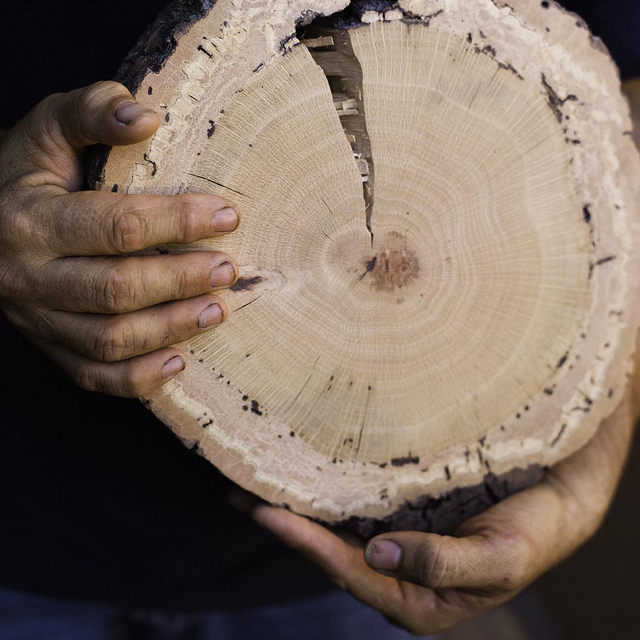RIVERSIDE, Calif. – A catastrophic infestation of the goldspotted oak borer, which has killed more than 80,000 oak trees in San Diego County in the last decade, might be contained by controlling the movement of oak firewood from that region, according to researchers at the University of California, Riverside.
“This may be the biggest oak mortality event since the Pleistocene (12,000 years ago),” said Tom Scott, a natural resource specialist. “If we can keep firewood from moving out of the region, we may be able to stop one of the biggest invasive pests to reach California in a long time.”
A cadre of UC researchers is leading the effort to assess and control the unprecedented infestation, in partnership with the U.S. Forest Service. Scott and others are working to identify where the infestation began, how it is spreading through southern California’s oak woodlands, and what trees might be resistant. In October 2010 Scott and other UCR researchers received $635,000 of a $1.5 million grant of federal stimulus money awarded to study the goldspotted oak borer and sudden oak death.
The goldspotted oak borer (Agrilus auroguttatus), which is native to Arizona but not California, likely traveled across the desert in a load of infested firewood, possibly as early as the mid-1990s, Scott said. Researchers have confirmed the presence of the beetle as early as 2000 near the towns of Descanso and Guatay, where nearly every oak tree is infested.
The half-inch-long beetle attacks mature coast live oaks (Quercus agrifolia), California black oaks (Quercus kelloggii) and canyon live oaks (Quercus chrysolepis). Female beetles lay eggs in cracks and crevices of oak bark, and the larvae burrow into the cambium of the tree to feed, irreparably damaging the water- and food-conducting tissues and ultimately killing the tree. Adult beetles bore out through the bark, leaving a D-shaped hole when they exit.
Scott and Kevin Turner, goldspotted oak borer coordinator for UC Agricultural and Natural Resources (ANR) at UCR, said that field studies in San Diego County in the last six months point strongly to the transportation of infested oak firewood as the source of the invasion that threatens 10 million acres of red oak woodlands in California.
Outbreaks have been found 20 miles from the infestation area, implicating firewood as the most likely reason for the beetle infestation leap-frogging miles of healthy oak woodlands to end up in places like La Jolla. In contrast, communities that harvest their own trees for firewood have remained relatively beetle-free, even as adjacent areas suffer unprecedented rates of oak mortality. Both examples support the growing conviction that the movement of infested firewood is the primary means by which the beetles are spreading, Scott said.
California’s coast live oaks, black oaks and canyon live oaks seem to have no resistance to the goldspotted oak borer and, so far, no natural enemies of the beetle have been found in the state.
The devastation can be measured in costs to communities and property owners for tree removal, the loss of recreation areas and wildlife habitat, lower property values and greater risk of wildfires. The three oaks under attack may be the single most important trees used by wildlife for food and cover in California forests and rangelands.
Most of the dead and dying trees are massive, with trunks 5 and 6 feet in diameter, and are 150 to 250 years old. The cost of removing one infested tree next to a home or in a campground can range from $700 to $10,000. The cost of removing dead and dying trees in San Diego County alone could run into the tens of millions of dollars. In Ohio, which has experienced similar losses from the emerald ash borer, several small cities went bankrupt because of tree removal costs associated with that beetle, Scott said.
So many oaks have died in the Burnt Rancheria campground on the Cleveland National Forest – a favorite spot for campers who favored the shade of a dense canopy of coast live oaks – that the Forest Service has had to erect shade structures. Other state and county parks in the region have suffered equally devastating losses.
Turner said an Early Warning System of community volunteers launched in San Diego County now includes representatives from every southern California county as far north as Ventura. Those volunteers are trained to monitor the health of oak trees in their communities and report any unusual changes.
At the same time, a network of UC Cooperative Extension, ANR, U.S. Forest Service and other agencies in the region is working with woodcutters, arborists and consumers to discourage the sale and transportation of infested wood. Wood that is bark-free or that has dried and cured for at least one year is generally safe to transport, Scott said. This relatively small change in firewood-handling methods could save a statewide resource without jeopardizing the firewood industry, he said.
Local, state and federal agencies recognize that firewood production is one of the least-regulated industries in California, and view UC Cooperative Extension education as the best means of stopping goldspotted oak borer movement in firewood.
“Quarantines don’t work, but enlightened self-interest can keep oak woodland residents from importing GSOB-infested firewood,” Scott said. “This is a situation where the university can play a critical role in changing behavior through research and education rather than regulation.”
A cross-section of an oak infested by the goldspotted oak borer shows the damage done by the non-native beetle.
To view original article, Click Here.
Related Links:
Goldspotted Oak Borer Information
GSOB Research at UCR
UC Cooperative Extension
Sep 12, 2011
Topics: